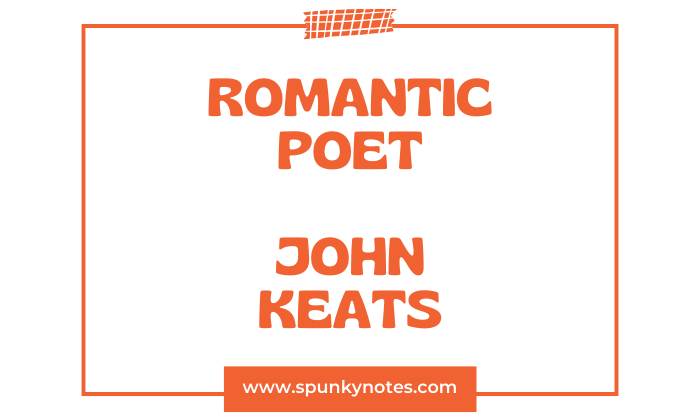
Q. Discuss John Keats as a romantic poet.
John Keats, born in 1795, was a significant Romantic poet known for his lyrical beauty and rich sensory descriptions. Although his life was tragically short, his poetry maintains a lasting impact on readers despite his premature death.
John Keats as a Romantic Poet
John Keats is recognized as a Romantic poet because he emphasizes the following traits.
- Intense Emotionality
- Appreciation of Nature
- Focus on Beauty
- Sensory Language
- Hellenism
- Idealization of the Past
- Escapism and Imagination
1- Intense Emotionality
The intense emotionality in John Keats’s poetry closely aligns him with the Romantic movement, a literary era that deeply valued personal emotion and individual experience. In his “Ode to a Nightingale,” Keats writes:
My heart aches, and a drowsy numbness pains
My sense, as though of hemlock I had drunk.
These lines illustrate the speaker’s profound emotional response to the nightingale’s song, blending sensations of pain and pleasure. This emotional depth is a hallmark of Keats’s work, showing his ability to convey complex emotions in a few lines.
Furthermore, in “Bright Star,” Keats expresses a deep yearning for stability and eternal love with the lines:
Still, still to hear her tender-taken breath,
And so live ever—or else swoon to death.
This passionate wish to capture a moment forever or face death emphasizes his intense emotional investment in moments of beauty and affection. Keats’s ability to portray such powerful emotions contributes significantly to the emotional intensity that defines much of Romantic poetry.
These examples from his work demonstrate how Keats used language to explore and express deep emotional states, making him a quintessential Romantic poet.
2- Appreciation of Nature
John Keats’s poetry demonstrates a deep appreciation of nature, which is a central theme in many of his works. This appreciation aligns with the Romantic movement’s emphasis on the beauty and inspirational qualities of the natural world.
In “To Autumn,” Keats personifies the season. He depicts autumn as filled with ripe fruits, ready harvests, and expanding growth.
Season of mists and mellow fruitfulness,
Close bosom-friend of the maturing sun.
Here, Keats highlights the harmony and abundance of autumn, showcasing his ability to find beauty in nature’s everyday aspects.
Additionally, in “Ode to a Nightingale,” Keats uses the natural symbol of the nightingale to express his longing for a transcendent experience away from human suffering:
Thou wast not born for death, immortal Bird!
No hungry generations tread thee down.
The nightingale represents a natural and eternal beauty contrasting human frailty and impermanence.
Keats’ focus on nature in these poems not only highlights his reverence for the natural world but also reinforces his place within the Romantic tradition, which celebrated nature as a source of inspiration and emotional depth.
3- Focus on Beauty
John Keats’s poetry is characterized by a profound appreciation for beauty, which he views as profoundly connected to truth. This perspective is a central theme in Romantic literature, emphasizing the importance of aesthetic experience.
In “Ode on a Grecian Urn,” Keats examines the enduring beauty of the art depicted on an ancient urn, emphasizing its lasting nature:
Thou still unravish’d bride of quietness,
Thou foster-child of Silence and slow Time.
Here, Keats suggests that the beauty of the urn outlives the short-lived realities of human existence.
Additionally, the final lines of “Ode on a Grecian Urn” express Keats’s belief in the inseparability of beauty and truth:
Beauty is truth, truth beauty, that is all
Ye know on earth, and all ye need to know.
Through these words, Keats affirms that understanding beauty is essential to grasping the truth. It indicates that beauty itself holds a profound, almost sacred, significance.
This treatment of beauty as not just aesthetic but also a moral truth reflects the Romantic inclination to elevate the importance of sensory and emotional experiences.
4- Sensory Language
John Keats’s poetry is marked by a vivid use of sensory language that brings his descriptions to life. This feature is particularly evident in his poem “Ode to a Nightingale,” where he not only listens to the bird’s song but also imagines tasting a vintage wine:
O for a draught of vintage! that hath been
Cool’d a long age in the deep-delved earth,
Tasting of Flora and the country green,
Dance, and Provençal song, and sunburnt mirth!
Additionally, he describes the effect of the wine:
O for a beaker full of the warm South,
Full of the true, the blushful Hippocrene,
With beaded bubbles winking at the brim,
And purple-stained mouth;
These lines engage multiple senses, including taste and sight, creating a rich, immersive experience. Keats enhances his poetry’s emotional depth and immediacy by evoking such detailed sensory images.
This technique is central to his style and helps establish his reputation as a Romantic poet who prioritizes personal and sensory experiences.
5- Hellenism
John Keats’s poetry often reflects a deep fascination with ancient Greek culture, a theme known as Hellenism. This interest is apparent in his use of Greek mythology and his idealization of classical beauty, which are evident in several of his works.
In “Ode on a Grecian Urn,” Keats directly engages with Greek art:
Thou still unravish’d bride of quietness,
Thou foster-child of Silence and slow Time,
Sylvan historian, who canst thus express
A flowery tale more sweetly than our rhyme.
Here, Keats explores the silent stories captured in the figures and scenes depicted on the ancient urn, celebrating Greek art’s enduring beauty and permanence.
Additionally, in “Hyperion,” a poem that draws heavily on Greek mythology, Keats delves into the world of the old gods and their downfall with the rise of the new Olympians:
Deep in the shady sadness of a vale
Far sunken from the healthy breath of morn,
Far from the fiery noon, and eve’s one star,
Sat gray-haired Saturn, quiet as a stone.
These references not only highlight Keats’s admiration for Greek culture but also show how he incorporated classical themes and characters into his poetry, using them to enrich his exploration of human and divine experiences.
6- Idealization of the Past
John Keats’s poetry often idealizes the past, reflecting a nostalgic reverence for history, especially of classical and medieval times. This idealization is a characteristic element of Romantic poetry.
In “La Belle Dame sans Merci,” Keats uses a medieval setting to tell the story of a knight enchanted by a mysterious woman:
O what can ail thee, knight-at-arms,
Alone and palely loitering?
The sedge has withered from the lake,
And no birds sing.
This narrative draws on the medieval tradition of chivalry and courtly love, highlighting Keats’ fascination with the values and aesthetics of bygone eras.
7- Escapism and Imagination
Keats’s poetry often reflects a desire to escape from the harsh realities of life into a world of imagination.
In poems like “Ode to a Nightingale,” he expresses a longing to transcend the limitations of human existence and find solace in the eternal beauty of nature and art.
Away! away! for I will fly to thee,
Not charioted by Bacchus and his pards,
But on the viewless wings of Poesy,
Conclusion
John Keats’ poetry shows Romantic traits through his profound emotional expression and deep appreciation for nature and beauty. His poetry highlights human emotions with sensitivity, using the natural world and the past as sources of inspiration.
Keats’ work demonstrates the Romantic ideals and the aesthetic experience, making him a central figure in the Romantic movement.

